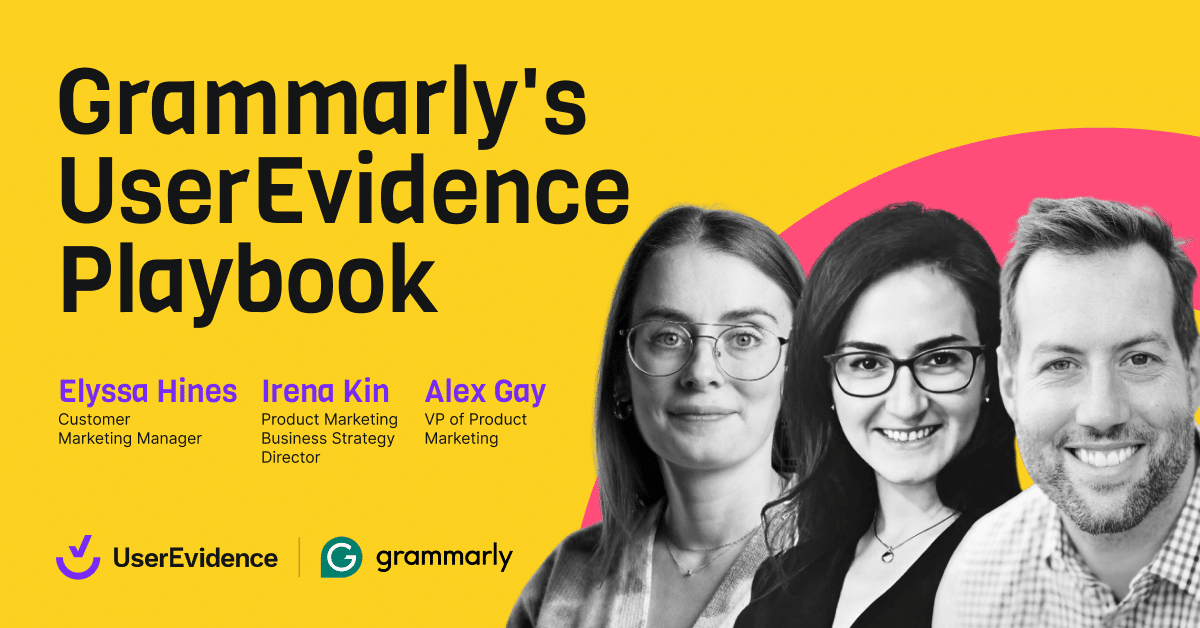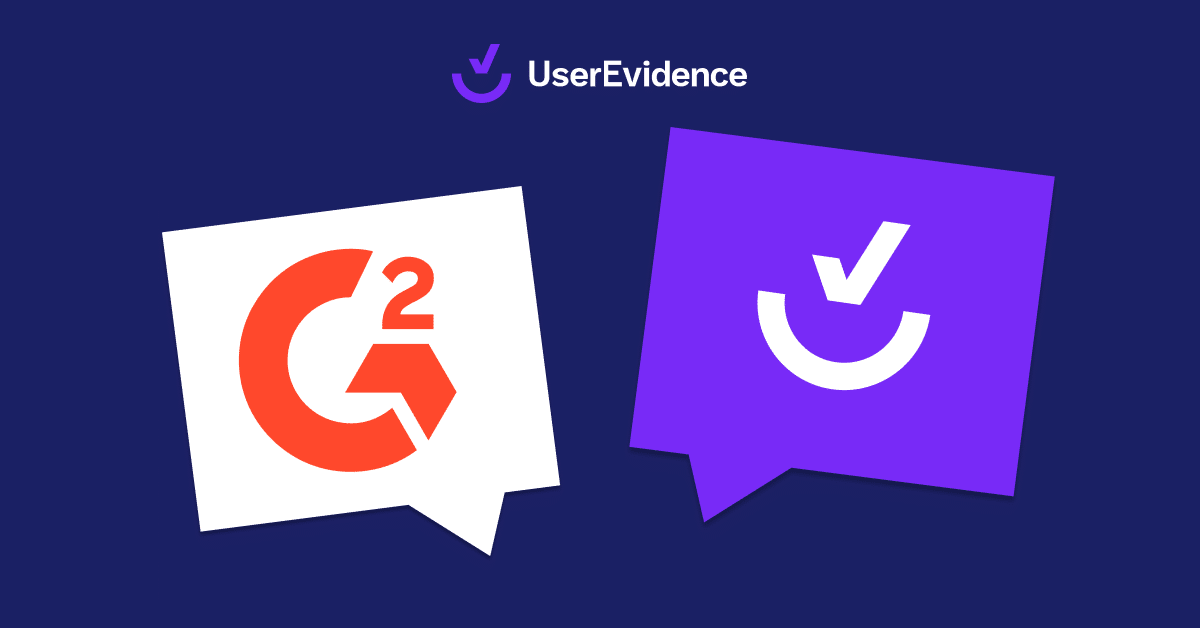The TL;DR
Struggling with case studies that are always on hold? You’re not alone.
Case studies might be the gold standard for marketing proof, but they’re notoriously time-consuming and painful to create. The good news? There are faster, more scalable ways to build your customer evidence library while you wait for those big projects to wrap.
We’re breaking down:
- How to spot your “evidence gaps” through internal interviews.
- Why creating an annual survey schedule can keep proof points flowing year-round.
- Tips for enabling your sales team with the right tools and updated proof.
- Quick wins with customer surveys to gather actionable insights now.
Whether you’re wrangling logos or hunting for fresh data, this guide has actionable strategies to make your customer evidence work harder—and smarter—for your marketing team.
My friend (and UserEvidence advisor) Devin Reed reminded me last week that as marketers we should always be looking to get the problem nod with our content.
Even if you don’t think you know what the problem nod is…you know what the problem nod is.
It’s when someone says something so relatable to you that you simply can’t help but emphatically nod along as they share the sentiment.
“Oh, this person GETS me.” you think, as you nod along.
That’s what we should be looking to get from our audience when messaging, positioning, and creating content.
And when I think of the easiest “problem nod” I can win when I’m talking to customer marketers…it’s what a PITA case studies are.
Case studies are a necessary evil–and notoriously hellish for marketers 99.9% of the time.
While the big, flashy logo’ed case studies carry their weight in the amount of airtime they get on sales calls, in follow-up emails, and on customer story pages–the blood, sweat, and tears it takes to get them there is undeniable.
The back-and-forths.
The stuck-in-legal reviews.
The “sorry for the delay–this slipped off my radar” emails.
I recently heard a customer marketer share that their latest case study took upwards of a year to create and get approval for. OOF.
It got me thinking: case studies will always be a part of the mix for every content marketer. Those big, flashy logos are hard to top. But with 51% of buyers saying they care more about statistical evidence than that latest flashy case study, it’s worth considering what other ROI stats and data-backed stories we can be mining for in the meantime.
Courtesy of our latest tactical guide, Closing The Evidence Gap, here are a few things you can do to start to beef up that customer evidence library while you’re waiting on that big case study project to wrap up.
Conduct internal interviews to see what proof is missing
A killer go-to-market (GTM) strategy isn’t just about flashy campaigns or slick sales decks—it’s about having the right customer proof at the right time. But here’s the catch: most teams don’t even know where their “evidence gaps” are. Enter: internal interviews. They’re a simple, effective way to uncover what’s missing and get your team firing on all cylinders.
Step 1: Rally the Troops
Gather your sales, marketing, customer success, and product teams. Each one has a front-row seat to the buyer’s journey and can shed light on what’s missing. For instance, your sales team might need vertical-specific case studies, while marketing might see prospects bouncing off certain pages.
Step 2: Ask the Right Questions
Keep it structured but conversational. Use prompts like:
- What objections do you hear most from prospects?
- What types of customer proof consistently seal the deal?
- Where do buyers hesitate or need extra reassurance?
Step 3: Listen for Patterns
Encourage candid conversations. Pay attention to recurring themes—like an unmet need for proof in specific industries or regions. Those patterns? That’s your evidence roadmap.
Step 4: Build an “Evidence Map”
Summarize what you’ve learned into a clear, actionable visual. Map out buyer touchpoints, common objections, and the proof types needed at each stage.
These interviews don’t just help you find the gaps—they create alignment. When everyone’s invested in the solution, your new proof strategies will stick.
Create a survey schedule for the upcoming year
Heyyyy, future you is calling! They reeeally want you to set a survey schedule so you’ve got proof points coming in all year round.
But on the real–I know that customer marketers often struggle with making sure they feel like their role is proving impact (seriously–our best performing article of all time is a guide to how customer marketing leaders can create major impact). So much of the job is reactive…so taking a little time now to be proactive for the upcoming year is going to help not only prove out the impact of your role a little more, but also going to stack your GTM team with crucial proof points that are flowing all year round.
A simple annual survey schedule ensures you’re gathering the data you need without overwhelming your audience (or your team).
Step 1: Pinpoint Your Goals
Decide what you want to learn:
- Are customers happy?
- What objections do prospects have?
- Why are deals getting stuck or falling through?
Step 2: Segment Your Audiences
Tailor surveys to different groups:
- Current Customers: Quarterly NPS or satisfaction surveys to track loyalty.
- Lost Deals: Quarterly surveys to uncover why buyers walked away.
- Prospects: Annual perception surveys to understand how your brand stacks up.
Step 3: Sync with Your Team’s Calendar
Plan surveys around key events, like product launches or quarterly reviews. For example:
- Q1: Post-deployment product feedback.
- Q2: Win/loss insights.
- Q3: Case study recruitment.
- Q4: Strategic planning input.
Step 4: Automate + Act
Use tools like HubSpot or SurveyMonkey to schedule, send, and track responses. Then, analyze the data, share insights with your team, and take action—whether that’s fixing usability issues or creating campaigns to tackle buyer objections.
Ok, let’s put all of this into hypothetical practice together.
Let’s say some of the company-wide priorities for the upcoming year are to push into EMEA, win more competitive deals, and break into the cyber industry.
I’d start thinking like this:
We start with a survey of the International customer base because that will support a company-wide annual initiative to break into the EMEA market. We need that specific data ASAP to support sales in those aggressive goals. Then, we’ll turn our energy to a census survey to gather as much Verified ROI as possible, hoping it’ll get some good industry-specific results that our sales team can share with that tricky Cyber buyer. If not, we’ll tackle that evidence gap with an industry-specific survey of our Cyber customers, with some additional incentives to hopefully pick up some of the more hesitant customers who didn’t partake in the Census survey.
And, voila! Our survey schedule for the year is set. Here’s how it all comes to life:
With this schedule all set, you can socialize it upward to the C-suite to get their buy-in (and, give yourself a little extra customer marketing street cred with this tangible example of how you’re gathering customer evidence that will help the company achieve its big-picture goals), and then the hard part is done. The plan is set, and all you’ve gotta do is execute.
Revisit how you enable your sales team with proof
Even the best sales team can’t sell without the right tools. If your customer proof is outdated, irrelevant, or hard to find, it’s time for a refresh.
Step 1: Audit What You Have
Catalog all your sales collateral. What’s working? What’s gathering dust? If your best case study is three years old, it’s time to update.
Step 2: Make It Easy to Access
Invest in a sales enablement platform like Highspot or Seismic. Create a centralized hub that integrates with your CRM, so your team can grab the right proof at the right moment.
Step 3: Train for Impact
Proof assets are only as good as the salespeople using them. Train your team to weave case studies or ROI calculators into their pitch. Run role-plays where reps practice using proof to overcome objections.
A quick refresh ensures your team has the tools they need to win more deals, more often.
Send out a customer survey
Remember that survey schedule we talked about earlier? If you’re less of a planner and more of a do’er, then this suggestion is just for you: just send out a customer survey already.
Surveys are goldmines for insights—if you do them right. Here’s how to make sure your surveys deliver:
1. Start with Clear Goals
Decide exactly what you want to learn: Why are customers renewing (or churning)? What’s holding back adoption of a new feature?
2. Keep It Short
Focus on 5–10 questions max. Shorter surveys = better response rates.
3. Mix It Up
Use both quantitative (e.g., “Rate your satisfaction 1–10”) and qualitative (“What’s one thing we could improve?”) questions for richer insights.
4. Offer a Little Something
Boost participation with small perks, like gift cards or early feature access.
5. Share + Act
Once the results are in, don’t just file them away. Share key findings with your team, and let respondents know how their feedback is shaping your next steps.
Regular surveys aren’t just about collecting data—they’re a way to show customers you value their input and are committed to continuous improvement.
If you want to see how UserEvidence can help you scale aaaaall of the above (survey scheduling, auditing your proof points, building your customer evidence library) check it out in action on our Demo Ranch.




